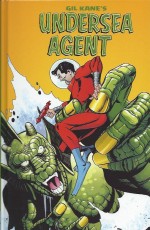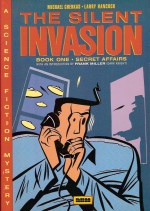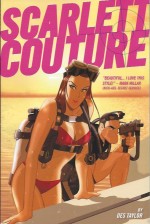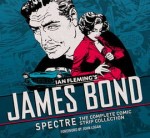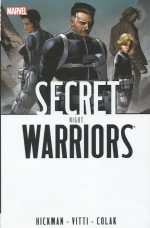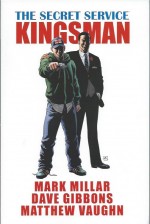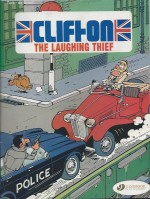
By De Groot & Turk, translated by Luke Spear (Cinebook)
ISBN: 978-1-905460-07-4
For some inexplicable reason most of Europe’s comics cognoscenti – most especially the French and Belgians – seem fascinated with us Brits. Maybe it’s our shared heritage of Empires lost and cultures in transition? An earlier age would have claimed it’s simply a case of “Know your Enemyâ€â€¦
Whether we look at Anglo air ace Biggles, indomitable adventurers Blake and Mortimer, the Machiavellian machinations of Green Manor or even the further travails of Long John Silver, the serried stalwarts of our Scepter’d Isles cut a dashing swathe through the pages of the Continent’s assorted magazines and albums.
And then there’s Clifton…
Originally devised by child-friendly strip genius Raymond Macherot (Chaminou, Les croquillards, Chlorophylle, Sibylline) for iconic Tintin Magazine, the doughty True Brit troubleshooter first appeared in December 1959. After three albums worth of material Рcompiled and released between 1959 and 1960 РMacherot left Tintin for arch-rival Spirou and his eccentric comedy crime-fighter sadly floundered until Tintin brought him back at the height of the Swinging London scene, courtesy of Jo-El Azaza & Greg (Michel R̩gnier).
These strips were subsequently collected as Les lutins diaboliques in French and De duivelse dwergen for Dutch-speakers in 1969.
Then it was back into retirement until the early 1970s when writer Bob De Groot and illustrator Philippe “Turk†Liegeois revived Clifton for the long haul, producing ten tales of which this – Le voleur qui rit – Clifton from 1973 – was their second collaboration.
Thereafter, from 1984 on, artist Bernard Dumont – AKA Bédu – limned De Groot’s scripts before eventually assuming the writing chores as well, until the series ended in 1995. In keeping with its rather haphazard nature and typically undying nature, the Clifton experience resumed once again in 2003, crafted by De Groot and Michel Rodrigue in four further adventures; a grand total of 25 to date.
The setup is deliciously simple: pompous and irascible Colonel Sir Harold Wilberforce Clifton, ex-RAF, former Metropolitan police Constabulary and recently retired from MI5, has a great deal of difficulty dealing with being put out to pasture in rural Puddington. He thus takes every opportunity to get back in the saddle, occasionally assisting the Government or needy individuals as an amateur sleuth.
Sadly for Clifton – as with that other much-underappreciated national treasure Captain Mainwaring in Dad’s Army – he is too keenly aware that he is usually the only truly competent man in a world full of blithering idiots…
In this second translated album – first seen in 2005 – the Gentleman Detective is embroiled in not one but two uncanny incidences, beginning with eponymous epic ‘The Laughing Thief’ wherein the still much-missed lawman rather forcefully inserts himself into a current case baffling Scotland Yard.
London is being wracked by devilishly clever crimes executed with infallible precision by a crack crew of blaggers, but the profits of each caper seem far below what such expert criminals should be bothering with. Moreover, each perfectly executed heist is preceded by a telephone warning from a braying braggart with the most annoying and distinctive laugh imaginable…
The crooks are incredibly bold and arrogant. Even after Clifton intervenes in the second robbery, the scoundrels easily outwit him, leave the dapper sleuth unconscious with dozens of other peculiarly proud and strangely supportive victims…
Moreover, although police “higher-ups†welcome Clifton’s help, officer-in-charge Lieutenant Hardfeeling doesn’t want the show-stealer around and is doing all he can to impede the Colonel’s investigations, despite the protests of his senior colleagues and the bobbies on the beat…
Nevertheless, persistence is its own reward, and when Clifton finally deduces the true reasons for the publicity-seeking crime-spree the resultant confrontation is both spectacularly satisfying and hilariously rewarding…
Being British and an ex-spy, Clifton has hung on to the odd gadget or two, such as an amazingly tricked out umbrella which plays a major part in this volume’s second tale ‘The Mystery of the Running Voice’. A suspenseful spooky yarn, it begins when the unhappy retiree meets old comrade Donald McDonald Muckyduck, who appears to have worn out every vestige of verve and is on the verge of a nervous breakdown…
Close consultation reveals that the former police Inspector is being haunted by a robber ghost; one that has already claimed six victims. However upon viewing the crime scene photos Clifton gains an inkling into how the trick is done and temporarily moves to bucolic village Flatfish-on-Apron, setting himself up as bait for a diabolical genius with a penchant for clever gimmicks…
Visually spoofing Swinging Sixties London and staidly stuffy English Manners with wicked effect, these gentle thrillers are big on laughs but also pack a lot of consequence-free action into their eclectic mix. Delightfully surreal, instantly accessible and doused with daft slapstick à la Jacques Tati and intrigue like Margaret Rutherford as Miss Marple, this brace of romps rattle along in the grand old tradition of Will Hay, Terry-Thomas and Alistair Sim – or Wallace and Gromit if you’re a callow yoof – offering readers a splendid treat and loads of timeless laughs.
Original edition © 1973 Le Lombard (Dargaud-Lombard S. A.) 1988 by De Groot & Turk. English translation © 2005 Cinebook Ltd.

